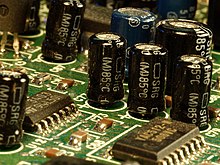A sound card (also known as an audio card) is an internal computer expansion card that facilitates the input and output of audio signals to and from a computer under control of computer programs. The term sound card is also applied to external audio interfaces that use software to generate sound, as opposed to using hardware inside the PC. Typical uses of sound cards include providing the audio component for multimedia applications such as music composition, editing video or audio, presentation, education and entertainment (games) and video projection. Many computers have sound capabilities built in, while others require additional expansion cards to provide for audio capability.
General characteristics
Sound cards usually feature a digital-to-analog converter (DAC), which converts recorded or generated digital data into an analog format. The output signal is connected to an amplifier, headphones, or external device using standard interconnects, such as a TRS connector or an RCA connector. If the number and size of connectors is too large for the space on the backplate the connectors will be off-board, typically using a breakout box, or an auxiliary backplate. More advanced cards usually include more than one sound chip to provide for higher data rates and multiple simultaneous functionality, for example digital production of synthesized sounds (usually for real-time generation of music and sound effects using minimal data and CPU time).
Digital sound reproduction is usually done with multichannel DACs, which are capable of simultaneous digital samples at different pitches and volumes and application of real-time effects, like filtering or distortion. Multichannel digital sound playback can also be used for music synthesis, when used with a compliance[clarification needed], and even multiple-channel emulation. This approach has become common as manufacturers seek simpler and lower-cost sound cards.
Most sound cards have a line in connector for an input signal from a cassette tape or other sound source that has higher voltage levels than a microphone. The sound card digitizes this signal and stores it (under control of appropriate matching computer software) on the computer's hard disk for storage, editing, or further processing. Another common external connector is the microphone connector, for signals from a microphone or other low-level input device. Input through a microphone jack can be used, for example, by speech recognition or voice over IP applications.Professional soundcards (audio interfaces)
Professional soundcards are special soundcards optimized for real-time (or at least low latency) multichannel sound recording and playback, including studio-grade fidelity. Their drivers usually follow the Audio Stream Input Output protocol for use with professional sound engineering and music software, although ASIO drivers are also available for a range of consumer-grade soundcards.
Professional soundcards are usually described as "audio interfaces", and sometimes have the form of external rack-mountable units using USB, FireWire, or an optical interface, to offer sufficient data rates. The emphasis in these products is, in general, on multiple input and output connectors, direct hardware support for multiple input and output sound channels, as well as higher sampling rates and fidelity as compared to the usual consumer soundcard. In that respect, their role and intended purpose is more similar to a specialized multi-channel data recorder and real-time audio mixer and processor, roles which are possible only to a limited degree with typical consumer soundcards.
On the other hand, certain features of consumer soundcards such as support for environmental audio extensions (EAX), optimization for hardware acceleration in video games, or real-time ambience effects are secondary, nonexistent or even undesirable in professional soundcards, and as such audio interfaces are not recommended for the typical home user.
The typical "consumer-grade" soundcard is intended for generic home, office, and entertainment purposes with an emphasis on playback and casual use, rather than catering to the needs of audio professionals. In response to this, Steinberg (the creators of audio recording and sequencing software, Cubase and Nuendo) developed a protocol that specified the handling of multiple audio inputs and outputs.
In general, consumer grade soundcards impose several restrictions and inconveniences that would be unacceptable to an audio professional. One of a modern soundcard's purposes is to provide an AD/DA converter (analog to digital/digital to analog). However, in professional applications, there is usually a need for enhanced recording (analog to digital) conversion capabilities.
What is CD-ROM Drive?
What is CPU ?
What is Floppy Disk Drive?
What is Fan?
What is Hard Disk Drive?
What is Mainboard or Motherboard?
What is Network Card?
What is Power Supply?
What is RAM?
What is Sound Card?
What is VGA?
Computer components:



No comments:
Post a Comment